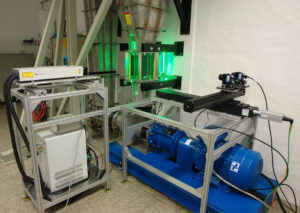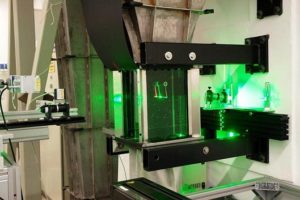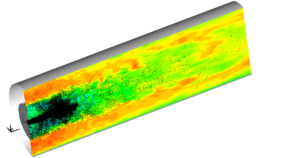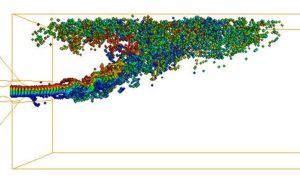Hybrid LES-RANS methods
Development and apllications of hybrd LES-RANS methods for turbulent flows of high Reynolds numbers, details under DFG CNRS Research Unit 507, A French-German Research Group LES of Complex Flows
Fluid-structure interaction in turbulent flows
Objectives:
1. Development and application of simulation methods for fluid-structure interactions in turbulent flows, cf.
DFG-Projekt BR 1847/12
2. Development of FSI benchmark test cases including experimental and numerical data.
Overview of turbulent FSI Benchmarks
Overview of laminar FSI Benchmarks
Some pictures and movies from recent works:
– Benchmark FSI-PfS-1a
UFR_2-13 on ERCOFTAC/QNET database
Turbulent Flow: Re = 30,470
Numerical FSI simulation results: Unsteady velocity distribution simulated using LES (left); structural deformation due to pressure and shear forces (right). pictures and video cooming soon
– Benchmark FSI-PfS-2a
UFR 2-14 on ERCOFTAC/QNET database
Turbulent Flow : Re = 30,470
Numerical FSI simulation results: Unsteady vorticity distribution simulated by LES. video cooming soon
– Experiment: Particle-Image Velocimetry in the water channel


– Links:
DFG – Research Unit 493 Fluid-Structure Interaction: Modelling, Simulation, Optimisation
Numerical simulation of multiphase flows
Development of numerical simulation methods for turbulent, particle-laden multiphase flows.
Objectives:
- Efficient Euler-Lagrange computational methods for highly charged flows.
- Consideration of particle-wall and particle-particle collisions.
- Use of modern methods for the continuous phase: LES, hybrid LES-URANS
- Efficient use of high-performance computers


Project:
Agglomeration and cluster formation of microscacle particles and droplets in highly loaded turbulent gas flows
DFG BR 1847/13
Letzte Änderung: 22. February 2021